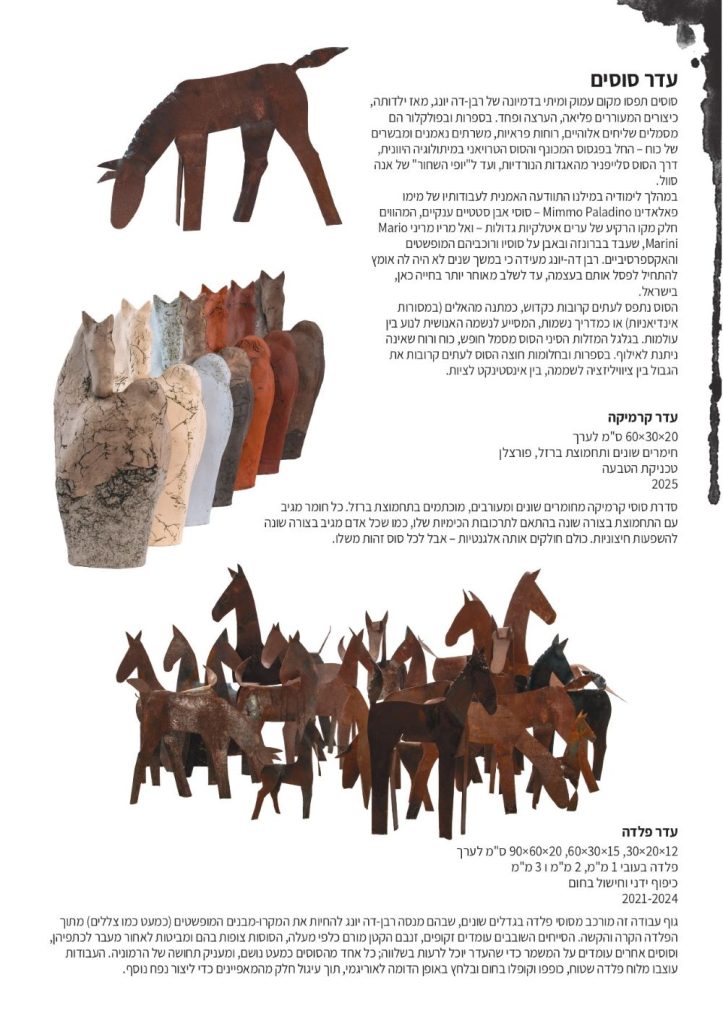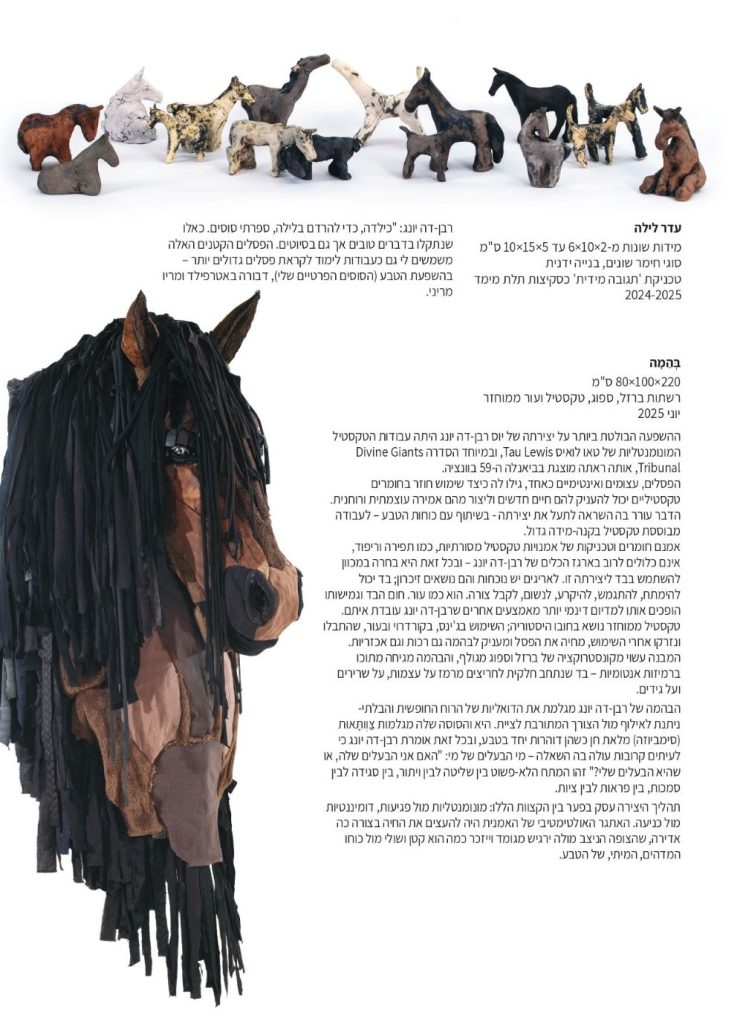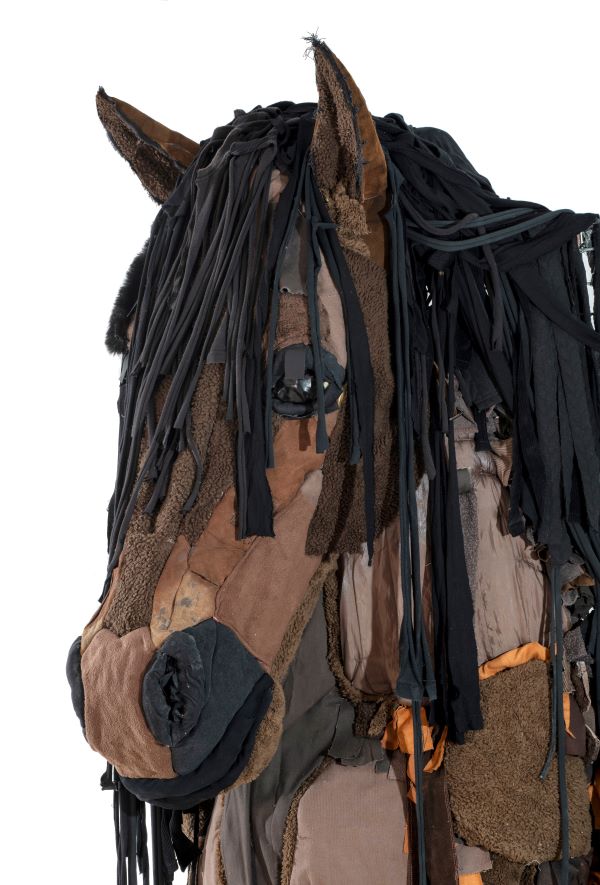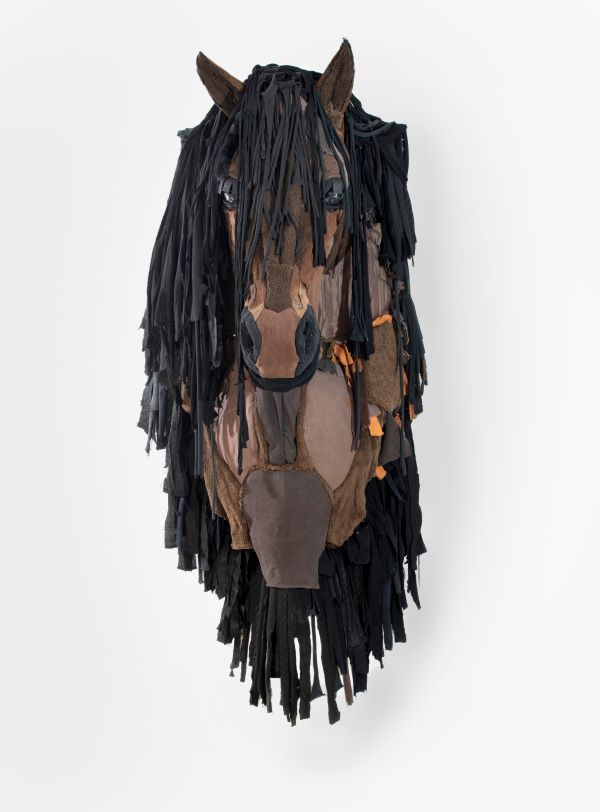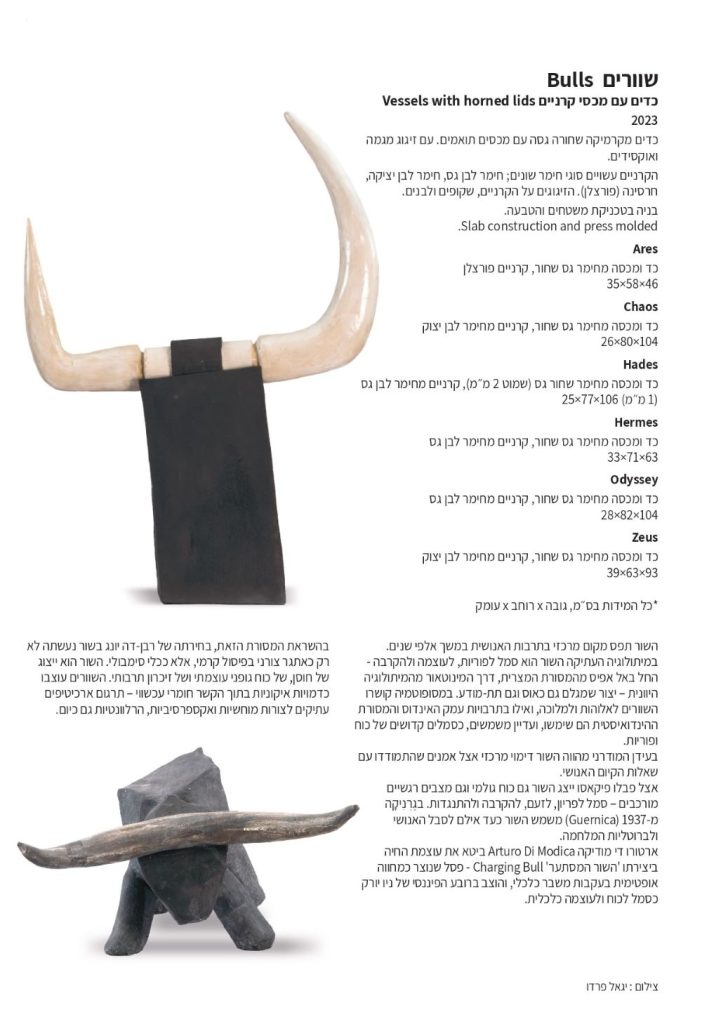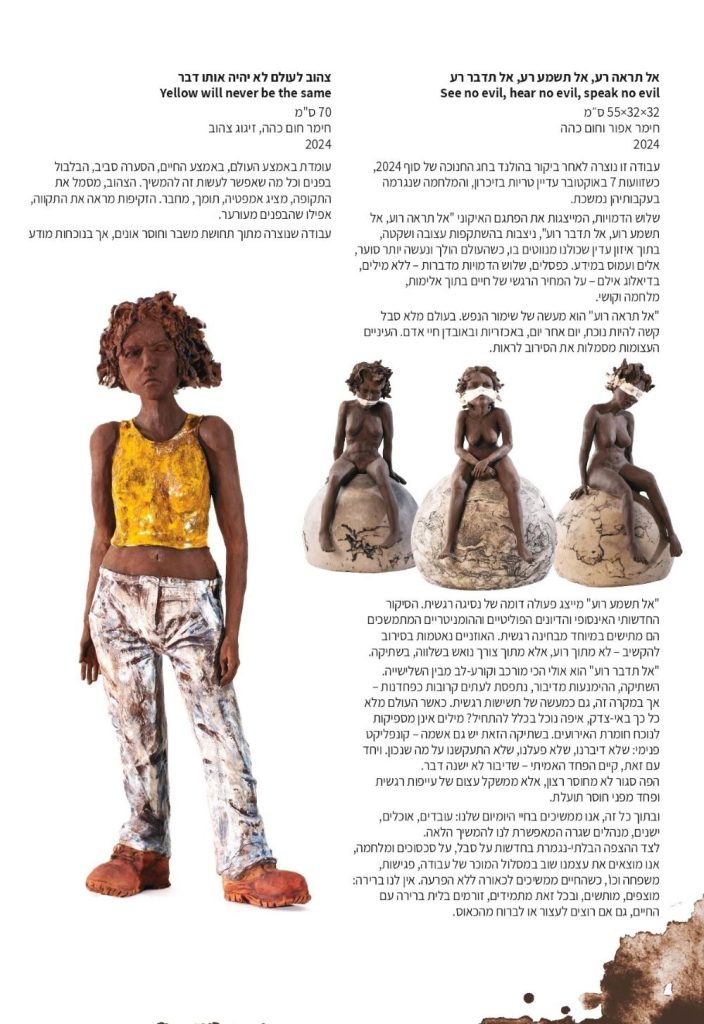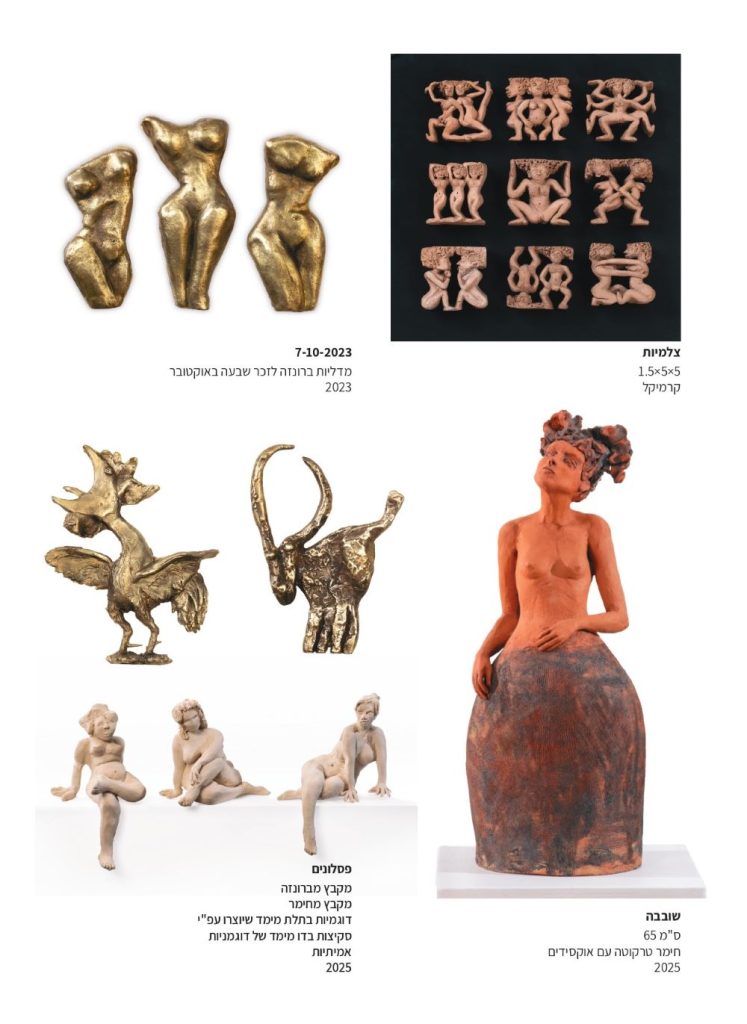
למרות ההזמנה לתאריך 11.7
בבוקר אותו היום התעורר העמק לבשורה קשה.
סרן רעי בירן, שגדל והתחנך בעמק
נפל במילוי תפקידו בעזה.
העמק הרכין ראש בעצב ובכאב
ופתיחתה החגיגית של התערוכה נדחה.
מועד חדש יפורסם בהמשך.
דבר האוצרת
חייה של יוס רבן-דה יונג מתאפיינים ברקע רב-תרבותי: ילידת הולנד, שהתגוררה באמסטרדם, בפריז, בברצלונה ובמדריד, בציריך, במינכן ובמילָנו, ודוברת 7 שפות. תחילה למדה בהולנד רפואה במשך כשנתיים, ואז עברה ללימודי אמנות מעשית במילנו. חייה נעו כל העת בין שני תחומים אלה – עיסוק טכני בציוד רפואי, לצד יצירה הנובעת ממעמקי הנפש.
המעבר מאירופה הקלאסית לישראל היה מבחינתה הלם תרבותי; אך בהדרגה התאהבה רבן-דה יונג בישראל ובישראלים ומצאה עניין רב בתערובת המוזרה של שילוב תרבויות, חיבורי מורשת ובמה שנוצר מהם כאן. בתקופת הריונה הראשון גילתה האמנית ממד נוסף של חיי היומיום הישראליים – קהילה ושייכות. סדרת המיניאטורות שלה, 'צלמיות', נוצרה באותה תקופה. כוח קדמון תמיד שימש לה מקור אנרגיה מניע, חסר גבולות, יחד עם האמונה הבלתי-מעורערת בטוב.
בעודה עוסקת בתחום ההייטק הרפואי, החליטה לחזור לתשוקתה הראשונה – ולמדה לתואר שני באמנות באוניברסיטת חיפה, בהנחייתם של אמנים מהשורה הראשונה בארץ. אובדן של קרובי משפחה עורר אותה לצעוד באופן מלא בעקבות ייעודה בתחום האמנות, והיא עברה להתמחות באקדמיה לפיסול. הלימודים היו לה תקופה מרעננת ומחזקת, שבה הבינה כי האמנות דורשת עבודה אינסופית: אף יצירת מופת אינה נולדת מהיום להיום, ולאמן אמיתי אין ברירה אלא להמשיך בעבודה.
רבן-דה יונג חיה בקיבוץ בעמק. בטבע, בשטח הפתוח, במרחבים היא מוצאת את מקומה הטבעי, מוקפת בבעלי חיים המספקים לה מקום מפלט משמעותי של שקט והשראה יומיומית לחייה. לאמנות שלה היא מביאה את החַיִּים, את החַיּוֹת ואת כוחות החַיּוּת, המלווים אותה עצמה. העוצמה וכוח החַיּוּת נובעים מתוכה, נוכחים במחשבותיה ובמעשיה, ולאורם מתנהלים חייה.
רבן-דה יונג אוהבת לחקור ולהתנסות בחומרים. היא מפסלת בברזל, בפלדה ובברונזה, מעצבת בחימר ובפורצלן, מגלפת באבן ובעץ, מאיירת ומציירת, ולתערוכה הנוכחית בחרה "לפסל" גם בטקסטיל. בדרך העיסוק בחומרים השונים היא מנסה למתוח גבולות ולהכניע את מה שנחשב ל"בלתי-אפשרי" עבור חומר מסוים.
מבחינתה, כל אתגר שמגיע לפִתחהּ – נועד לפַתֵּחַ אותה. זה הלך הרוח שממנו היא שואבת את היצירה שלה – באמצעות דמויות של בעלי חיים, בשאיפה לבטא את האנרגיה הראשונית הטבועה בטבע, ולהנכיח את הכוח המתגלה באופן העוצמתי והמיוחד לכל אחד. כך היא גורמת לחומר "מת" להתעורר לחיים ולהפוך ליצירה שבה ניתן לחוש נשימה וחיוּת, או לזהות את הרוח והאנרגיה של היצור החי.
בעבודותיה של יוס מסמלים הסוסים והשוורים את עוצמת הטבע – וכך גם נשים וצלמיות, ארכיטיפים קדומים המייצגים חוסן, כוח וזיכרון תרבותי, ואלה הופכים אצלה למוחשי, שמתאים ורלוונטי לזמננו אנו.
עד עתה הציגה רבן דה-יונג בתערוכות קבוצתיות רבות בארץ ובעולם. בתערוכת יחידה ראשונה זו ניתן לראות את העושר והרבגוניות שלה ביצירה, בסוגי חומרים, ב"טיפוסים" שהיא מביאה לקדמת הבמה, ובעיקר בעוצמה הטמונה בה עצמה – ומועברת ממנה אל יצירותיה.
הדר מקובר מרום,
אוצרת.
The Power of Life
The life of Jos Raban-de Jongh is characterized by a rich multicultural background. Born in the Netherlands, she has lived in Amsterdam, Paris, Barcelona, Madrid, Zurich, Munich, and Milan — and speaks seven languages. She initially studied medicine in the Netherlands for about two years before shifting her focus to practical art studies in Milan. Throughout her life, she has moved back and forth between two distinct worlds: technical work with medical equipment and artistic creation that derives from the depths of her soul.
Her move from classical Europe to Israel was a true culture shock. But gradually, Raban-de Jongh fell in love with Israel and its people, intrigued by the remarkable blend of cultures, the interwoven legacies, and the unique expressions born from that mix. During her first pregnancy, the artist discovered another dimension of Israeli daily life — a sense of community and belonging. It was during this period that she created her series of miniatures, Tzalmiyot (Figurines). A primal force has always been her source of boundless creative energy, together with an unshakable belief in goodness.
While engaging in the field of medical high-tech, she decided to return to her first passion — and pursued a Master’s degree in Fine Arts at the University of Haifa, studying under leading Israeli artists. The loss of close family members prompted her to commit fully to her artistic calling, and she went on to specialize in sculpture at a dedicated academy. This period of study was both refreshing and empowering — a time in which she understood that art demands tireless effort: no masterpiece is born overnight, and a true artist has no choice but to keep on working relentlessly in order to get results.
Raban-de Jongh currently lives on a kibbutz in the Jezreel Valley. It is in nature — in wide open spaces — that she finds her natural place, surrounded by animals that provide her with a meaningful refuge of serenity and daily inspiration. She brings into her art life, animals, and the vital forces that accompany her very being. That power and vitality come from within, present in her thoughts and actions, illuminating the way in which she conducts her life.
The artist loves to experiment with materials. She sculpts in iron, steel, and bronze; designs with clay and porcelain; carves in stone and wood; illustrates and paints — and for this current exhibition, she chose to “sculpt” in textiles as well. Through her exploration of different materials, she seeks to push boundaries and defy the "impossible" for any given medium.
For Raban-de Jongh, every challenge that comes to her door is meant to develop her more. This is the spirit from which her work is inspired — through animal figures, aiming to express the primal energy inherent in nature, and to embody the unique and powerful force that reveals itself differently in each being. In her hands, inanimate matter awakens to life, becoming creations that seem to breathe with vitality, where one can sense the spirit and energy of living creatures.
In her work, stallions and bulls symbolize the raw power of nature. So, too, do her depictions of women and figurines — ancient archetypes representing resilience, strength, and cultural memory — which she makes tangible and relevant to our own time.
To date, Raban-de Jongh has taken part in numerous group exhibitions in Israel and abroad. This, her first solo exhibition, offers a glimpse into the richness and diversity of her creative world — in the variety of materials she employs, the "characters" she brings center stage, and above all, in the inner strength she channels into her creations and transmits through them.
Hadar Macover MaRom
Curator
